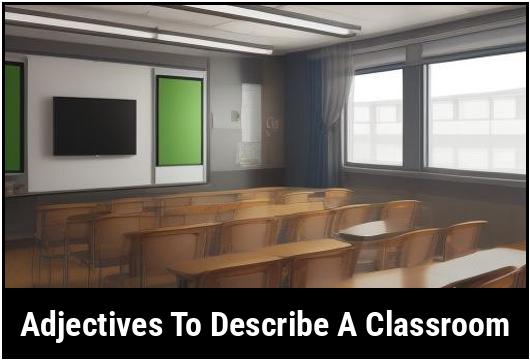- You are here:
- Home »
- adjectives
- » 31 Adjectives To Describe A Classroom

31 Adjectives To Describe A Classroom
Adjectives are powerful tools that help us vividly portray the characteristics and qualities of a classroom. By using adjectives, we can effectively convey the atmosphere, ambiance, and overall setting of a learning space. This article delves into the various adjectives that can be used to describe a classroom, aiming to provide an extensive understanding of how to aptly capture the essence of this environment.
Key Takeaways
- Adjectives play a crucial role in painting a detailed picture of a classroom.
- The careful selection and utilization of adjectives can significantly enhance the description of a classroom.
- Understanding the different types of adjectives can aid in effectively capturing the nuances of a classroom.
Adjectives To Describe A Classroom
1. Welcoming
A welcoming classroom greets students with open arms, creating a sense of belonging and acceptance. It invites students to be themselves and fosters a positive learning environment.
2. Engaging
An engaging classroom captivates students’ attention, stimulating their curiosity and motivating them to actively participate in the learning process. It provides a space that encourages exploration and fosters a love for learning.
3. Collaborative
A collaborative classroom promotes teamwork and cooperation among students. It encourages them to work together, share ideas, and learn from one another, cultivating important interpersonal skills.
4. Interactive
An interactive classroom encourages hands-on participation and active involvement. It incorporates various tools, technologies, and activities to enhance student engagement and understanding.
5. Nurturing
A nurturing classroom provides an environment that supports students’ emotional and academic growth. It acknowledges their individual needs, offers guidance, and fosters a sense of care and empathy.
6. Inclusive
An inclusive classroom celebrates diversity and ensures that every student feels valued and included. It embraces and accommodates individual differences, creating equal opportunities for all learners.
7. Inspirational
An inspirational classroom sparks enthusiasm and motivates students to set ambitious goals. It exposes them to new ideas, encourages critical thinking, and instills a sense of purpose.
8. Stimulating
A stimulating classroom offers a rich learning environment that excites and challenges students’ intellect. It includes thought-provoking materials, encourages inquiry, and ignites curiosity.
9. Supportive
A supportive classroom provides students with the necessary resources, assistance, and guidance to help them succeed. It offers a safety net that encourages risk-taking and growth.
10. Adaptive
An adaptive classroom flexibly adjusts to the diverse needs of its students. It caters to various learning styles and preferences, ensuring that students have the opportunity to thrive.
11. Structured
A structured classroom establishes routines and expectations, providing a predictable and organized learning environment. It promotes discipline, responsibility, and effective time-management skills.
12. Respectful
A respectful classroom fosters an atmosphere of mutual respect among students and between students and teachers. It encourages active listening, empathy, and understanding.
13. Disciplined
A disciplined classroom creates an environment where students understand and adhere to rules and regulations. It promotes self-control, responsibility, and a focused approach to learning.
14. Enthusiastic
An enthusiastic classroom is filled with energy and excitement. It radiates a passion for learning that is infectious, elevating student engagement and motivating them to reach their fullest potential.
15. Dynamic
A dynamic classroom is constantly evolving and adapting to meet the needs of its learners. It embraces change, encourages innovation, and keeps students engaged through diverse teaching methods.
16. Empowering
An empowering classroom aims to develop students’ autonomy and confidence. It encourages them to take ownership of their learning, make choices, and become active participants in their education.
17. Technology-Integrated
A technology-integrated classroom harnesses the power of technology to enhance the learning experience. It utilizes digital tools and resources to engage students, promote digital literacy, and prepare them for the future.
18. Thought-Provoking
A thought-provoking classroom prompts students to think critically and deeply about various concepts. It poses challenging questions, encourages analysis, and sparks meaningful discussions.
19. Safe
A safe classroom provides an environment where students feel physically and emotionally secure. It cultivates trust, supports risk-taking, and fosters a sense of well-being.
20. Creative
A creative classroom nurtures imagination and innovation. It encourages students to express themselves through various mediums, fostering artistic skills and innovative problem-solving abilities.
21. Reflective
A reflective classroom encourages students to evaluate their progress, learn from their mistakes, and set goals for personal growth. It promotes self-awareness and lifelong learning.
22. Fun
A fun classroom injects joy and excitement into the learning process. It incorporates games, activities, and humor to make learning enjoyable and to enhance student engagement.
23. Resourceful
A resourceful classroom utilizes a wide range of materials, literature, and technology to provide diverse learning opportunities. It equips students with the tools they need to explore, research, and create.
24. Growth-oriented
A growth-oriented classroom emphasizes the importance of effort, resilience, and a growth mindset. It celebrates and recognizes progress, motivating students to embrace challenges and persevere.
25. Discourse-rich
A discourse-rich classroom fosters meaningful conversations and debates. It encourages active participation, critical thinking, and the respectful exchange of ideas.
26. Empathetic
An empathetic classroom promotes understanding and compassion. It cultivates an environment where students support and care for one another, fostering a sense of community.
27. Innovative
An innovative classroom embraces new ideas and teaching methods. It encourages experimentation, creativity, and the incorporation of cutting-edge technologies to enhance the learning experience.
28. Open-minded
An open-minded classroom welcomes diverse perspectives and encourages students to challenge their own beliefs. It fosters an environment of tolerance, respect, and acceptance.
29. Organized
An organized classroom maintains order and structure, allowing for smooth transitions and efficient use of time. It supports effective teaching and learning by providing a clear framework.
30. Motivating
A motivating classroom inspires students to set and achieve their goals. It provides meaningful incentives, recognizes accomplishments, and instills a sense of motivation and drive.
31. Transformative
A transformative classroom has the power to change lives. It empowers students, opens doors to new possibilities, and prepares them to make a positive impact on the world.
Why Use Adjectives To Describe A Classroom
Adjectives are essential in providing a comprehensive and nuanced description of a classroom. Whether it’s a bustling, lively classroom filled with vibrant discussions, or a serene, contemplative space for individual study, adjectives are instrumental in articulating the unique characteristics of a learning environment.
By using adjectives, educators, students, or even observers can convey the ambiance, mood, and general vibe of a classroom. This, in turn, allows for vivid and detailed portrayals, helping individuals better comprehend, analyze, and envision the classroom setting.
How To Choose The Right Adjective To Describe A Classroom
Choosing the right adjectives to describe a classroom requires careful consideration of the specific aspects and qualities that you intend to convey. One should take into account elements such as the physical layout, the interactions within the space, the learning atmosphere, and the overall feeling evoked by the classroom.
To select the most suitable adjectives, it’s essential to observe and reflect on the classroom’s nature and dynamics. This involves paying attention to the students’ behavior, the teaching style, the décor, and the overall energy within the space.
Types Of Adjectives For Describing A Classroom
Descriptive Adjectives
Descriptive adjectives are used to vividly depict the physical attributes, appearance, and spatial characteristics of a classroom. They aid in creating a detailed visual representation of the environment. Descriptive adjectives can include terms such as "spacious," "colorful," "airy," "bright," "cluttered," or "organized."
Emotional Adjectives
Emotional adjectives are employed to convey the mood, ambiance, and general feeling within a classroom. These adjectives emphasize the emotional resonance and the overall atmosphere. Examples of emotional adjectives include "welcoming," "engaging," "uplifting," "calm," "stimulating," or "serene."
Interpersonal Adjectives
Interpersonal adjectives center around the interactions, dynamics, and relationships within the classroom. These adjectives illuminate the interpersonal connections, the communication style, and the social dynamics. They may encompass adjectives such as "collaborative," "supportive," "friendly," "inclusive," "participative," or "empowering."
Academic Adjectives
Academic adjectives are utilized to express the educational environment, the level of intellectual stimulation, and the learning culture within a classroom. These adjectives spotlight the academic engagement, the intellectual pursuits, and the cognitive atmosphere. Examples of academic adjectives include "intellectual," "challenging," "innovative," "knowledge-driven," "inspiring," or "thought-provoking."
Adjectives serve as indispensable tools in articulating the myriad aspects of a classroom. By employing descriptive, emotional, interpersonal, and academic adjectives, one can offer a rich and comprehensive portrayal of the physical, emotional, social, and intellectual dimensions of a learning space. As such, mastering the use of adjectives is paramount in effectively communicating and understanding the complex tapestry of the classroom environment.
Examples Of Adjectives For Different Types Of Classroom
Describing a classroom involves not only the physical environment but also the atmosphere, activities, and interactions within. Adjectives are powerful tools that can paint a vivid picture and convey the essence of a classroom to the reader or listener.
Before delving into the details, let’s first explore some common types of classrooms and the adjectives that can be used to describe them. By categorizing classrooms, we can understand the nuances of each type and tailor our descriptions accordingly.
-
Traditional Classroom
- Cozy: Imagine a traditional classroom with warm lighting, comfortable furniture, and a pleasant atmosphere that promotes focus and concentration.
- Organized: Describing a traditional classroom as organized implies that everything is in its proper place, with papers neatly arranged, resources easily accessible, and a logical layout.
- Interactive: If a classroom encourages collaboration, communication, and engagement among students, "interactive" is the perfect adjective to showcase its dynamic environment.
-
Modern Classroom
- High-tech: In a modern classroom, cutting-edge technology is often used to enhance learning. Describing it as high-tech highlights the presence of interactive whiteboards, computers, tablets, or other digital tools.
- Flexible: The modern classroom embraces adaptability and versatility. Describing it as flexible implies that the furniture can be rearranged to accommodate different learning styles and activities.
- Innovative: A modern classroom emphasizes creative thinking and experimentation. Employing the adjective "innovative" effectively conveys the use of unconventional teaching methods and techniques.
-
Creative Classroom
- Colorful: A creative classroom is often filled with vibrant colors that stimulate inspiration and imagination. Using the adjective "colorful" paints a picture of an environment that encourages creative expression.
- Expressive: Describing a creative classroom as expressive conveys the idea that it is a space where students can freely express their ideas, thoughts, and emotions without limitations.
- Playful: A classroom that fosters creativity often incorporates playfulness. Describing it as playful evokes a sense of joy, exploration, and lightheartedness.
-
STEM Classroom
- Scientific: A STEM classroom focuses on science, technology, engineering, and mathematics. Describing it as scientific emphasizes the emphasis on logical thinking, experimentation, and problem-solving.
- Cutting-edge: STEM classrooms are often at the forefront of technological advancements. Using the adjective "cutting-edge" highlights the presence of advanced equipment, such as 3D printers, robotics kits, and microscopes.
- Analytical: STEM classrooms give importance to critical thinking and data analysis. Describing them as analytical showcases the emphasis on hypothesis testing, data interpretation, and logical reasoning.
-
Inclusive Classroom
- Welcoming: An inclusive classroom aims to create a safe and accepting environment for all students. Describing it as welcoming highlights the warmth, inclusivity, and acceptance that radiates within it.
- Diverse: Inclusive classrooms celebrate diversity and honor different cultures, backgrounds, and learning abilities. Describing them as diverse emphasizes the variety of perspectives, experiences, and talents present.
- Supportive: An inclusive classroom provides support for students with different needs. Describing it as supportive conveys the idea that teachers and peers are there to assist and encourage one another.
Common Mistakes In Using Adjectives To Describe A Classroom
While adjectives can greatly enhance the description of a classroom, it is essential to use them correctly to avoid unintended misinterpretations or confusion. Here are some common mistakes to avoid:
-
Mismatched Adjectives: Ensure that the adjectives you choose accurately describe the specific features of the classroom. A mismatched adjective can lead to ambiguity or an inaccurate portrayal. For example, describing a traditional classroom as "high-tech" creates a contradiction.
-
Overused Adjectives: Avoid relying on cliched or overused adjectives that may not effectively convey the desired message. Instead, strive for originality and choose words that capture the essence of the classroom uniquely.
-
Lack of Specificity: Vague or generic adjectives can weaken the description of a classroom. Instead, be specific and provide concrete details that paint a clear picture in the reader’s mind.
-
Inconsistent Tone: Maintaining a consistent tone throughout the description is crucial. Be mindful of the overall mood you want to convey and choose adjectives that align with that tone.
-
Overloading Adjectives: While it may be tempting to use a multitude of adjectives to describe a classroom, it is important to exercise restraint. Overloading the description with too many adjectives can overwhelm the reader and dilute the impact of each word.
Using Adjectives Effectively
To effectively use adjectives in describing a classroom, there are a few key guidelines to follow:
-
Consider the Purpose: Determine the purpose of your description. Are you trying to evoke a specific emotion, highlight certain features, or provide an overall impression? Understanding your objective will help you select the most appropriate adjectives.
-
Use Sensory Language: Engage the reader’s senses by incorporating sensory language in your description. Consider how the classroom looks, sounds, smells, and feels. This not only adds depth to the description but also helps the reader fully immerse themselves in the environment.
-
Be Specific and Concrete: Use adjectives that provide specific details about the classroom. Instead of saying a classroom is "nice," describe the specific elements that make it so, such as comfortable seating, colorful decorations, or abundant natural light.
-
Create Imagery: Use adjectives that create vivid mental images. By selecting words that evoke strong visuals, you can transport the reader into the classroom, allowing them to experience it through their imagination.
-
Balance the Adjectives: Strike a balance between providing enough adjectives to paint a comprehensive picture while avoiding overwhelming the reader. Thoughtfully select a mix of adjectives that collectively capture the essence of the classroom.
Exercises And Practice
To improve your ability to describe classrooms effectively, here are some exercises and practice suggestions:
-
Observation Exercise: Visit a classroom and observe its surroundings carefully. Take note of the physical elements, atmosphere, and any unique features. Practice describing the classroom using a variety of adjectives, aiming to capture its essence accurately.
-
Adjective Brainstorm: Create a list of adjectives that you believe best describe a classroom. Challenge yourself to come up with a diverse range of words, both common and uncommon.
-
Adjective Swap: Take a piece of writing or a description of a classroom and replace the adjectives with your own choices. Consider how the new adjectives impact the overall imagery and mood of the description.
-
Peer Feedback: Share your descriptions with a friend or classmate and ask for their feedback. Encourage them to identify the strengths and weaknesses of your adjectives and suggest ways to improve them.
-
Writing Prompts: Use writing prompts to practice describing different types of classrooms. For example, "Describe a futuristic classroom equipped with the latest technology" or "Describe a classroom designed for hands-on learning." Challenge yourself to incorporate a variety of adjectives in each description.
Conclusion
Describing a classroom using adjectives allows us to paint a vivid picture and effectively convey its atmosphere and characteristics. By considering the type of classroom, using adjectives appropriately, and practicing descriptive writing, we can create engaging and immersive descriptions. Remember to be specific, consider the purpose of your description, and engage the reader’s senses. With practice, you can develop the skill of using adjectives effectively to bring any classroom to life in the minds of your readers or listeners.
FAQS On Adjectives To Describe A Classroom
What Are Some Commonly Used Adjectives To Describe A Classroom?
Some commonly used adjectives to describe a classroom are organized, engaging, serene, collaborative, and well-equipped.
Can You Provide An Explanation For The Adjective "organized" When Describing A Classroom?
When a classroom is described as organized, it typically means that it is tidy, well-structured, and everything has its designated place. This creates a sense of order and makes it easier for students to focus and navigate the classroom.
How Would You Define An "engaging" Classroom?
An engaging classroom is one that promotes active learning and encourages students to participate and interact with the material. It often includes various teaching strategies and activities that spark curiosity and promote critical thinking.
What Does It Mean For A Classroom To Be Described As "serene"?
A serene classroom is one that is calm, peaceful, and free from distractions. It is a conducive environment for learning, allowing students to feel relaxed and focused.
Why Is "collaborative" An Important Adjective To Describe A Classroom?
Using the adjective "collaborative" to describe a classroom emphasizes the importance of teamwork and cooperation among students. It also suggests that the classroom encourages open communication and a sense of community, leading to a more positive learning experience for students.









